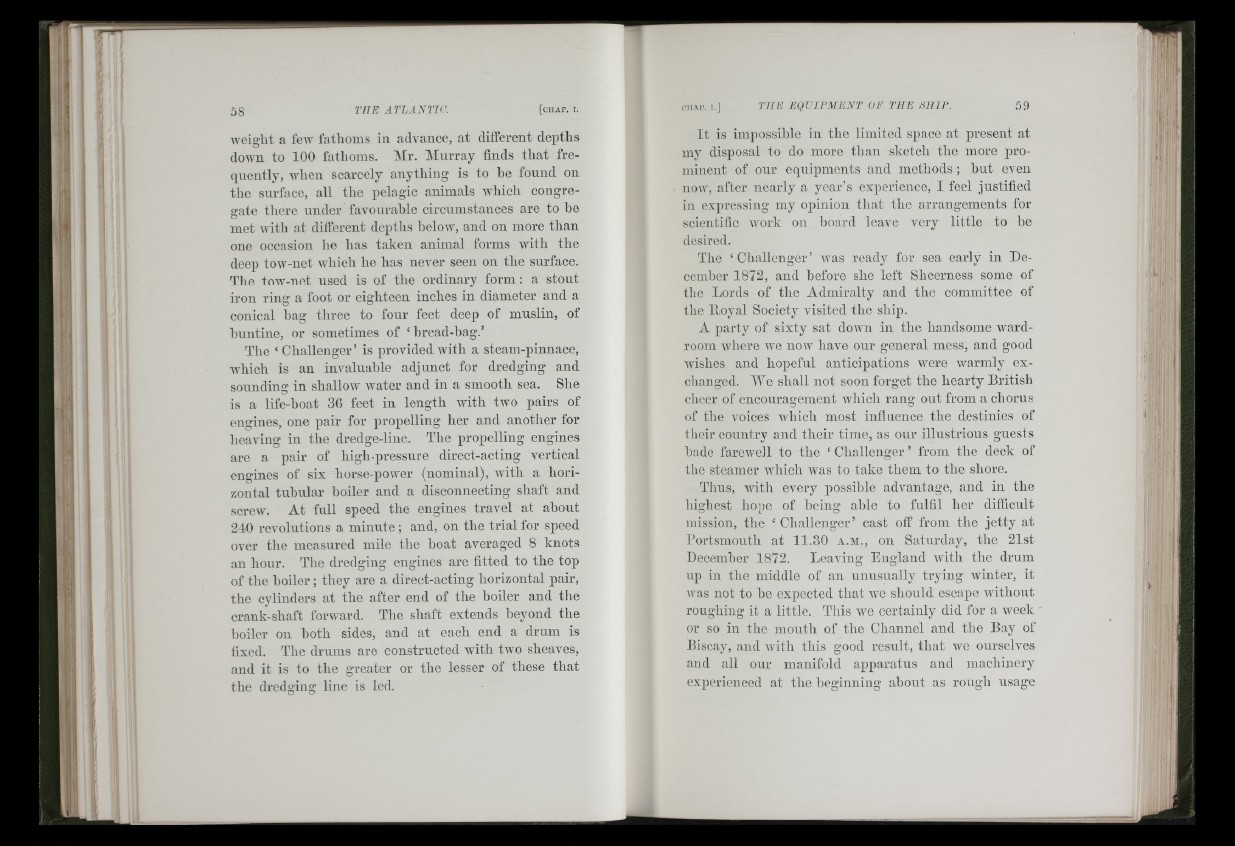
i I
J«
i*
k!Í#
58
weight a feAv fathoms in advance, at different depths
down to 100 fathoms. Mr. Murray finds that frequently,
Avlien scarcely anything is to be found on
tbe surface, all the pelagic animals Avhich congregate
there under favourable circumstances are to he
met Avitb at different depths below, and on more than
one occasion he has taken animal forms with the
deep toAV-net Avhich he has never seen on the surface.
The toAv-net used is of the ordinary fo rm : a stout
iron rinor a foot or eighteen inches O ^ in diameter and a
conical hag three to four feet deep of muslin, of
huntine, or sometimes of ‘ hread-bag.’
The ‘ Challenger’ is provided with a steam-pinnace,
Avhich is an invaluable adjunct for dredging and
sonndim? in shalloAV Avater and in a smooth sea. She
is a life-hoat 36 feet in length Avith tAvo pairs of
engines, one pair for propelling her and another for
heaving in the dredge-line. The propelling engines
are a pair of high-pressure direct-acting vertical
engines of six horse-poAA’er (nominal), Avith a horizontal
tubular holler and a disconnecting shaft and
screAV. At full speed the engines travel at about
240 revolutions a m in u te ; and, on the trial for speed
over the measured mile the boat averaged 8 knots
an lioAxr. The dredging engines are fitted to the top
of the holler; they are a direct-acting horizontal pair,
the cylinders at the after end of the boiler and tlie
crank-shaft foiuvard. The shaft extends heyond the
boiler on both sides, and at each end a drum is
fixed. The drums are constructed with twm sheaves,
and it is to the greater or the lesser of these that
the dredging line is led.
It is impossible in the limited space at present at
my disposal to do more than sketch the more prominent
of our equipments and methods ; hut even
now, after nearly a year’s experience, I feel justified
in expressing my opinion that the arrangements for
scientific Avork on board leave very little to be
desired.
Tbe ‘ Cballenger’ Avas ready for sea early in December
1872, and before sbe left Sbeerness some of
tbe Lords of the Admiralty and tbe committee of
tbe Royal Society visited tbe ship.
A party of sixty sat doAvn in tbe handsome wardroom
where Ave noAV ha\’e our general mess, and good
Avisbes and hopeful anticipations were warmly exchanged.
M^e shall not soon forget the hearty British
cheer of encouragement Avhich rang out from a chorus
of the voices Avbicb most influence tbe destinies of
tbeir country and tbeir time, as our illustrious guests
bade farewell to tbe ‘ Cballenger ’ from the deck of
tbe steamer AA’bich Avas to take them to the shore.
Thus, Avith every possible advantage, and in the
highest bone of being able to fulfil her difficult O L O
mission, the ‘ Challenger’ cast off from the jetty at
Portsmouth at 11.30 a .m . , on Saturday, the 21st
December 1872. Leaving England Avith the drum
up in the middle of an unusually trying winter, it
AA’as not to he expected that Ave should escape Avithont
roughing it a little. This M’e certainly did for a Aveek '
or so in the mouth of the Channel and the Bay of
Biscay, and Avith this good result, that we ourselves
and all our manifold apparatus and machinery
experienced at the heginning about as rough usage
í: íü ;